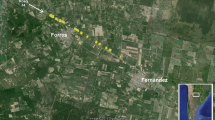Abstract
Ten-year height data from three open-pollinated lodgepole pine progeny test trials were analysed in order to select individuals for seed orchard establishment in the low and high elevation seed-planning units (TOLO and TOHI) of the new Thompson Okanagan seed planning-zone in interior British Columbia, Canada. The total test population had about 35,000 individuals from 362 families of 9 provenances and was divided into two portions, each serving as the base population for its appropriate seed-planning unit. For each population, various genetic parameters were estimated and individual breeding values were predicted. Combined-site estimates of individual, family, and within-family heritability ranged from 0.23 to 0.38, 0.77 to 0.84, and 0.17 to 0.29, respectively. Estimated coefficients of type-b genetic correlation were greater than 0.81, indicating little G × E interaction in this region. Provenance effects were large. Larch Hills and Inonoaklin River were the two superior provenances with an expected gain of 13% and 10% in stem volume at rotation age of 60 years in TOLO. Individual breeding values was not uniformly distributed among provenances and the top 100 individuals originated from 20 families in TOLO and 32 families in TOHI. Co-ancestry among these individuals should not be a serious concern in seed orchard establishment as the predicted genetic loss due to excessive inbreeding is only 1.06% in TOLO and 0.6% in TOHI. The status numbers of the two prospective seed orchards are 32 and 44, respectively, and both are well above the required minimum of 10 in British Columbia. Using unrelated clones for seed orchard establishment may result in reduced optimum genetic gain and thus is not a favourable option.

Similar content being viewed by others
References
Becker WA (1975) Manual of quantitative genetics. Washington State University Press, Pullman
Borralho NMG, Cotterill PP, Kanowski PJ (1992) Genetic parameters and gains expected from selection for dry weight in Eucalyptus globules ssp. globulus in Portugal. Forest Sci 38:80–94
British Columbia Ministry of Forests and BC Environment (1995) Seed and vegetative material guidebook. 57 pp
Burdon RD (1977) Genetic correlation as a concept for studying genotype–environment interaction in forest tree breeding. Silvae Genet 26:168–175
Carlson MR, Murphy CJ (1996) Genetic improvement of Lodgepole Pine. Experimental Project Progress Report. Res. Branch, BC Min. For. 36 pp
Cockerham CC (1963) Estimation of genetic covariances. In: Hanson WD, Robison HF (eds) Statistical genetics and plant breeding. National Research Council Publ. 982, National Academy of Sciences, Washington, DC
Ericsson T, Danell ö, Andersson B (1994) Genetic variation of Pinus contorta var. latifolia breeding material in Sweden. Can J For Res 24:723–729
Forest Genetics Council of British Columbia (2001) Forest Genetics Council of BC 2001–2002 Business Plan. Forest Renewal BC. 27 pp
Greaves BL, Borralho NMG, Yarmond CA, Farrington A (1996) Use of pilodyn for indirect selection of basic density in Eucalyptus nitens. Can J Forest Res 26:643–650
Hannerz M, Saliy NA, Ericsson T, Ying CC (2001) Inheritance of strobili production and genetic correlation with growth in lodgepole pine. Forest Genet 8:323–329
Lambeth CC (1980) Juvenile–mature correlations in Pinaceae and implications for early selection. Forest Sci 26:571–581
Lester DT, Ying CC, Konisi JD (1990) Genetic control and improvement of planning stock. In: Lavender DP, Parish P, Johnson CM, Montgomery G, Vyse RA, Willis RA, Wintson D (eds) Regenerating British Columbia’s forests. The University of British Columbia Press, Vancouver BC
Lindgreen D, Gea LD, Jefferson PA (1995) Status number for measuring genetic diversity. Forest Genet 4:69–76
McAuley L (1998) Interior SPZ review report. British Columbia Ministry of Forests, Victoria, BC Internal Rep
N.C. State University–Industry Cooperative Tree Improvement Program (1998) 42nd Annual report. 24 pp
Olsson T, Lindgreen D, Li B (2001) Balancing genetic gain and relatedness in seed orchard. Silvia Genet 50:222–227
Rehfeldt GE (1987) Components of adaptive variation in Pinus contorta from the Inland Northwest. USDA For Serv. Res. Pap. INT-375
Robertson A (1959) The sampling variance of the genetic correlation coefficient. Biometrics 15:469–485
Satterthwaite FE (1946) An approximate distribution of estimates of variance components. Biom Bull 2:110–114
SAS Institute Inc (1988) SAS procedure guide, release 6.03 ed. SAS Institute Inc., Cary N.C.
Shelbourne CJA (1972) Genotype–environment interaction: Its study and its implications in forest tree improvement. In Proceedings of Joint Symposia for the Advancement of Forest Tree Breeding of the Genetics Subject Group, IUFRO, and Section 5, Forest Trees, SABRAO. The Government Forest Experiment Station of Japan, Tokyo. pp B-1 I 1–28
Tibbits W, Hodge G (1998) Genetic parameters and breeding value predictions for Eucalyptus nitens wood fiber production traits. Forest Sci 44:587–598
Wang T, Aitken SN, Woods JH, Polsson K, Magnussen S (2004) Effects of inbreeding on coastal Douglas-fir growth and yield in operational plantations: a model-based approach. Theor Appl Genet 108:1162–1171
White TL, Hodge GR (1989) Predicting Breeding Values with Applications in Forest Tree Improvement. Kluwer Academic Publ., Boston, 367 pp
Xie C-Y, Yanchuk AD (2003) Breeding values of parental trees, genetic worth of seed orchard seedlots, and yields of improved stocks in British Columbia. West J Appl For 18:1–13
Xie C-Y, Ying CC (1996) Heritabilities, age–age correlations, and early selection in lodgepole pine (Pinus contorta ssp.Latifolia). Silvae Genet 45:101–107
Yamada Y (1962) Genotype by environment interaction and genetic correlation of the same trait under different environments. Jpn J Genet 37:498–509
Author information
Authors and Affiliations
Corresponding author
Rights and permissions
About this article
Cite this article
Xie, C.Y., Carlson, M.R. & Murphy, J.C. Predicting individual breeding values and making forward selections from open-pollinated progeny test trials for seed orchard establishment of interior Lodgepole Pine (Pinus contorta ssp. latifolia) in British Columbia. New Forests 33, 125–138 (2007). https://doi.org/10.1007/s11056-006-9018-3
Received:
Accepted:
Published:
Issue Date:
DOI: https://doi.org/10.1007/s11056-006-9018-3




